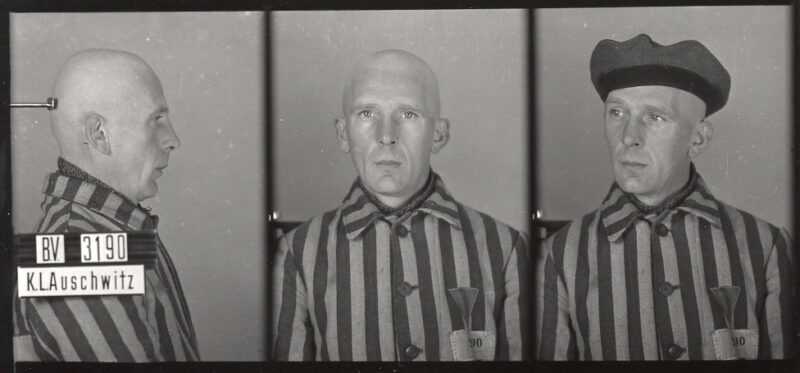Dr. Anna Hájková is a historian who teaches and works at the University of Warwick. She has been advocating for the remembrance and recognition of Willy Brachmann for many years. In June 2023, a Stolperstein (stumbling stone) was laid in his honour in Hamburg’s St. Pauli district. In her text, Anna Hájková commemorates Willy Brachmann as a helper and protector in the concentration camp.
In addition to the omnipresence of violence and death, survivors of the Theresienstadt family camp in Auschwitz also remembered a prisoner functionary: Willy Brachmann. Many described Willy Brachmann, who wore a green triangle, as a helpful man. In September 1943, the SS appointed him Kapo in the family camp—a section of the Auschwitz-Birkenau concentration camp where men, women, and children from Theresienstadt were imprisoned together, i.e., without prior selection. In March 1944, he became camp elder (»Lagerältester«).
In this role, Brachmann brought food to a pregnant woman and shared stories about how he felt when his own wife was expecting their child. František Schnurmacher, a young farmer from South Bohemia, recalled in the 1980s that if he ever saw Brachmann on the street, he would invite him to his dacha without hesitation. Brachmann also protected the clandestine communist resistance group in the family camp. He brought food to the artist Dina Gottliebová, and over time, the two developed a relationship. Gottliebová recounted how their initially physical connection evolved into a romantic one: she grew to admire and love Brachmann, even arranging for a prisoner dentist to make him a prosthesis. Additionally, Brachmann befriended a 12-year-old boy from Prague, Míša Grünwald, who became his messenger.

Photo: The Archive of The State Museum Auschwitz-Birkenau in Oświęci
The SS closed the family camp in July 1944. After a brutal selection process, young and able-bodied prisoners were deported for forced labour, while the elderly, infirm, and children were murdered. Brachmann smuggled Grünwald past the SS doctors during the selection process. He also managed to save a young Jewish woman from Hamburg, Anita Landsberger. His altruistic acts placed his own life in grave danger. Today, Míša, now known as Frank Grunwald, lives in Indianapolis and continues to honour the Kapo who saved his life, campaigning for Brachmann’s recognition.
Willy Brachmann was born in St. Pauli in 1903. During the First World War, while his father was drafted to the front, Willy became one of tens of thousands of adolescents who resorted to theft to support their starving families. His first prison sentence came in the summer of 1918, and his last in 1946. Brachmann became a house painter, married, and in 1927, had a daughter. The small family faced many difficulties: Willy’s wife suffered from bone tuberculosis, and money was always scarce. To prevent his wife and daughter from freezing and to pay medical bills, Willy turned to stealing. He broke into cellars, taking heating materials and other items of little value.
When the Nazis came to power in 1933, Willy Brachmann sought a fresh start and joined both the NSDAP and the National Socialist People’s Welfare Organisation (NSV). However, his membership in the party was short-lived, he was expelled just a year later.
In 1938, after completing another prison sentence, Brachmann was not released but was instead sent to a concentration camp as a »career criminal«. This was based on the 1934 “Law against Dangerous Habitual Criminals and on Measures of Security and Correction” (»Gesetz gegen gefährliche Gewohnheitsverbrecher und über Maßregeln der Sicherung und Besserung«), which rested on the socio-racist Nazi belief in an inherent predisposition to criminality. Brachmann was first interned in the Emsland camps, from where the SS transferred him to Sachsenhausen concentration camp in 1939. In August 1940, the Nazis deported him to Auschwitz concentration camp. There, he was assigned to work in the painting and road construction detachment. Brachmann was imprisoned twice in the infamous »bunker« (punishment block) for stealing supplies for his friends. Although he survived, he lost nearly all his teeth.
In the autumn of 1944, Brachmann was transferred to the Auschwitz subcamp in Gleiwitz. In January 1945, he was sent on a death march to the Groß Rosen concentration camp. Two months later, he managed to escape from a death transport and found his way to Hamburg, where he went into hiding until the liberation. After the war, Brachmann was arrested again for theft. In the 1960s, he fought for compensation for the suffering he endured in the concentration camps. However, his claims were denied, as compensation was not granted to those classified as »career criminals«.
Die SS (»Schutzstaffel«) unter der Leitung von Heinrich Himmler versteht sich als elitärer Wehrverband des nationalsozialistischen Staates. Mit der Übernahme und dem Umbau der Polizei durch Himmler wird die SS zum zentralen Terrorinstrument des Regimes. 1934 erhält sie erhält die Kontrolle über sämtliche Konzentrationslager. Das 1939 gebildete Reichssicherheitshauptamt, die Planungszentrale für die Verbrechen im deutsch besetzten Europa, ist ihr zugeordnet.
Der SD (Sicherheitsdienst des Reichsführers SS) wird 1931 durch den Reichsführer SS Heinrich Himmler zunächst als Nachrichtendienst der SS (Schutzstaffel) gebildet und soll Informationen über politische Gegner/-innen und Oppositionsströmungen innerhalb der Nationalsozialisten sammeln. Ab 1934 wird der SD zum Nachrichtendienst der NSDAP. Er untersteht Reinhard Heydrich, der den SD 1939 im neugebildeten Reichssicherheitshauptamt mit der Sicherheitspolizei (Gestapo und Kripo) zusammenlegt.
Als »Gewohnheitsverbrecher« gelten seit den 1920er Jahren Personen, die wegen mehrerer Straftaten verurteilt sind. Bereits Ende 1933 nimmt die nationalsozialsozialistische Regierung diese Personengruppe mit einem eigenen Gesetz ins Visier. »Gefährlichen Gewohnheitsverbrechern« spricht die nationalsozialistische Justiz ab, sich bessern zu können, weil sie Kriminalität für vererbbar hält. Gegen diese Menschen ordnen Richter unbefristete »Sicherungsverwahrung« an. Später werden sie häufig auch als »Berufsverbrecher« bezeichnet.
In den Konzentrationslagern ernennt die SS einige Gefangene zu sogenannten Häftlingsvorarbeitern. Für eine bessere Behandlung müssen sie ihre Mithäftlinge überwachen und Anweisungen der SS durchsetzen. Diese beabsichtigte Umkehr von Opfer und Täter führt zu Misstrauen und Spaltung unter den Gefangenen. In vielen Erinnerungsberichten beschreiben Überlebende die sogenannten Kapos oder Funktionshäftlinge als gewalttätig und grausam.